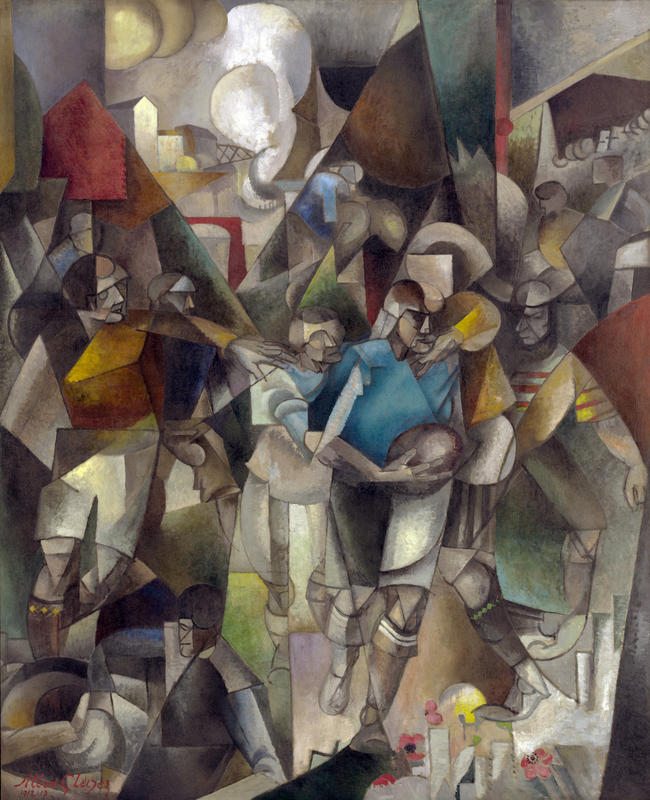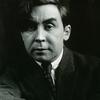More about Football Players

Sr. Contributor
Apparently, Europeans can’t agree on what they mean when they say football, not even when there are paintings that exist called Football Players.
Everyone knows about the classic “American football” versus “soccer” debate, but it wasn’t always this way. Before World War I, when a European said “football,” it referred to rugby, not soccer. This isn’t just an Albert Gleizes thing, either. The Football Players by Henri Rousseau shows a jolly bunch playing rugby out in the middle of the woods, which is totally normal, right? At least Gleizes had the decency to put his players on a proper pitch with spectators and all. That is, if you can make out what’s actually going on in this painting.
Although his may not be the first name that comes to mind when you think of Cubism, Albert Gleizes and his pal Jean Metzinger wrote the book on Cubism – literally. It’s called Du “Cubisme.” During this phase of his career, Gleizes was still grappling with the human form. By 1915, he became an all-out abstractionist.
Gleizes didn’t exactly make this image easy to understand. The Cubist idea of simultaneity, that everything is happening at the same time in all dimensions, complicates how we perceive the image. The earlier study for this painting reveals more about the artist’s process. Gleizes began with a simplified, figurative version of the rugby scene to iron out the kinks of the composition. This painting is the cubism-infused final version that keeps us guessing. If you look closely, you can also learn more about contemporary life in Paris. The team in blue is most likely the real rugby team Stade Français, and this is a scene of them playing at their home field.
Despite his relative obscurity now, art-savvy folks know Gleizes. This painting eventually caught Nelson Aldrich Rockefeller’s eye, and he purchased it in 1955. You’d better believe he had a good eye for twentieth-century modern art. Nelson was the son of Abby Aldrich Rockfeller, one the three women who founded the Museum of Modern Art.
Sources
- Bee, Harriet S., and Michelle Elligott. Art in Our Time: A Chronicle of The Museum of Modern Art. New York: The Museum of Modern Art, 2004.
- Harrison, Charles, and Paul Wood. “Albert Gleizes and Jean Metzinger from Cubism.” Art in Theory, 1900–2000: An Anthology of Changing Ideas. Malden, MA: Blackwell Publishing, 2014.
- Miller, Arthur I. “Three wise men, two worlds, and one idea.” The Independent. 23 February 1997. https://www.independent.co.uk/arts-entertainment/three-wise-men-two-wor…. Accessed 27 March 2020.
- National Gallery of Art. “Football Players.” Collection. https://www.nga.gov/collection/art-object-page.52106.html#provenance. Accessed 27 March 2020.
- Solomon R. Guggenheim Foundation. “Albert Gleizes.” Collection Online. https://www.guggenheim.org/artwork/artist/albert-gleizes. Accessed 27 March 2020.
- The Art Story. “Salon Cubism Movement.” Movements. https://www.theartstory.org/movement/salon-cubism/. Accessed 27 March 2020.
- Vere, Bernard. “On Albert Gleizes, Cubism, and Sports in Art.” News & Events. Sotheby’s Institute of Art. https://www.sothebysinstitute.com/news-and-events/news/on-albert-gleize…. Accessed 27 March 2020.
Featured Content
Here is what Wikipedia says about Football Players
Football Players (French: Les Joueurs de football) is a 1912–13 painting by the French artist Albert Gleizes. The work was exhibited at the Salon des Indépendants, Paris, March–May 1913 (no. 1293). September through December 1913 the painting was exhibited at Erster Deutscher Herbstsalon, Berlin (no. 147). The work was featured at Galeries Dalmau in Barcelona, 29 November – 12 December 1916 (no. 31), Gleizes' first one-person show. The work was again exhibited at Galeries Dalmau 16 October – 6 November 1926 (no. 7). Stylistically Gleizes' Football Players exemplifies the principle of mobile perspective laid out in Du "Cubisme", written by himself and French painter Jean Metzinger. Guillaume Apollinaire wrote about Les Joueurs de football in an article titled "Le Salon des indépendants", published in L'Intransigeant, 18 March 1913, and again in "A travers le Salon des indépendants", published in Montjoie!, Numéro Spécial, 18 March 1913.
Les Joueurs de football was left by the artist at Galeries Dalmau in 1916. Titled Jugadors de Futbol, the painting was reproduced in the avant-garde Catalan magazine L'Amic de les arts, November 1926. The caption included the inscription Collection Joseph Dalmau.
It was purchased from the Dalmau family between 1953 and 1955 by Stephen Hahn and (The Sidney Janis Gallery); sold in 1955 to Nelson Aldrich Rockefeller, New York. Subsequently the work was sold to the Marlborough-Gerson gallery, New York, and purchased May 1970 by the National Gallery of Art (NGA), Washington D.C.
Check out the full Wikipedia article about Football Players












